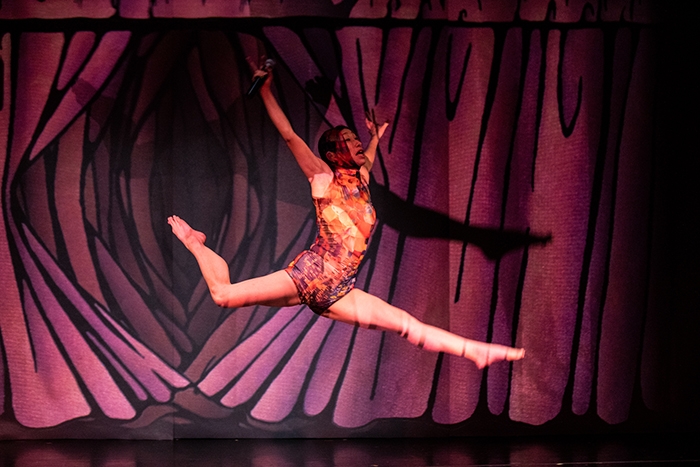Tabaimo is drawing. On a whiteboard. Her back to the house. The people filing in don’t seem to notice, absorbed as they are with talk of how “Americans aren’t taking it seriously,” while maintaining poses designed to convey that they are taking it very seriously. Hey – I get it. My hands are washed. My nails scrubbed. And yet here we are out in public, on the cusp of epidemic and pandemic, for the last event that many of us will see before the museums go dark.
The performance ‘officially’ begins with a man vigorously erasing the whiteboard. The lights dim, and on this clean slate a projected silhouette appears: shown from the waist up, arms akimbo. Where the board ends, two human legs begin. In a simulation of wholeness, they dance and jiggle, buoyed by a percussive soundscape. The illusion is charming. We laugh. Even when the torso and legs split and struggle to reconcile – like Peter chasing his shadow – even then, perhaps to stave off darker associations, we laugh.
This opening scene encapsulates many of the vignettes in Fruits borne out of rust, which Tabaimo is staging in collaboration with choreographer Maki Morishita, dancer Chiharu Mamiya, composers Yusuke Awazu and Keisuke Tanaka, and two on-stage musicians. Body and animation are caught in an ongoing dance, neither certain about whom is leading or following. A garment worn by Mamiya can at any moment become a screen, as in one compelling scene when it fills with teeming microbial life. Projections play across a hanging scrim that bisects upstage, where musicians become visible in certain lighting conditions, and downstage. Mamiya disappears behind it, as if through a gap in animated wood planks, and later weaves her arms through slits in the fabric to mimic the structure of illustrated roots.
These details pass quickly in a performance that, like Tabaimo’s well-known video installations, is constantly in transformation. A bedroom turns into a cage where Mamiya and a drawn dove hop about, followed by a scene of an animated hand reaching out to claim the agitated dancer. Such symbols come fast and obvious – but thankfully, in moderation. Soon after, we’re left alone with Mamiya. (No music. No screens. Just her body, clasping and twisting.) In another vignette, she delivers an incredible performance: a monologue, alluding to a past medical procedure, told in fragmented movement and vocal bursts. “Pineapples! I want pineapples!” Mamiya comedically shrieks, as her body strikes a number of clenched, pained poses. Moments later, she transforms into an entirely different character, cowering by the scrim and confessing that “sometimes, I’m really afraid that anything can happen from one moment to the other.”
The title Fruits borne out of rust suggests that aging, neglect and decay can yield positive things. The performance emphatically (and heavy-handedly) makes this point, at the very end, as animated flowers unfurl from Mamiya’s heart. But it’s the scenes of the dancer taking centre stage that get to the emotional core of this idea, when we see the artistic expression that can come from a person struggling with a history of pain. Uncaged and unadorned by Tabaimo’s illustrations, her body is both the limit and the means of transformation.
Tyler Coburn is an artist and writer based in New York
First published online 18 March 2020
